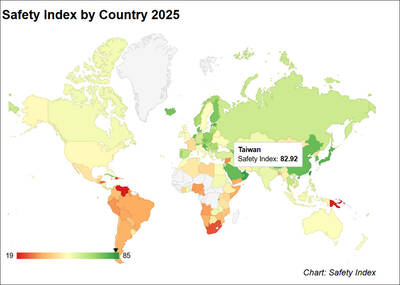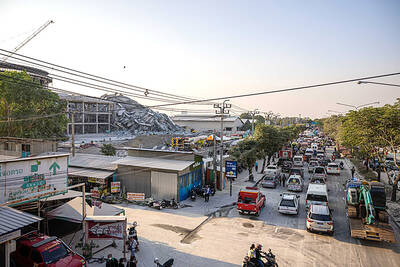A newly declassified US intelligence report claims that China is developing electromagnetic pulse (EMP) weapons for use in a future conflict with Taiwan.
EMP weapons can be used to emit a huge pulse of electromagnetic radiation that can knock out all electronics — particularly computers — over a widespread area.
The privately run National Security Archive in Washington has released the report, which was produced in 2005 by the US National Ground Intelligence Center.
The report speculates that Beijing might be trying to develop a capability to incapacitate Taiwan electronically without triggering a US nuclear retaliation.
Analysts believe that China could be planning to cause a massive low-altitude EMP burst over Taiwan in such a way that it would severely damage electronics in Taiwan — disabling weapons systems — but kill few people and not impact China.
The archive has gained access to a total of 2,300 US declassified intelligence papers, which it is making available under the title US Intelligence and China: Collection, Analysis and Covert Action.
The papers cover the period from 1945 until last year and include covert action operations by the US and Taiwan in the 1950s and 1960s aimed at weakening the Chinese Communist Party’s hold in China.
“For use against Taiwan, China could detonate at a much lower altitude — 30 to 40 kilometers — to confine the EMP effects to Taiwan and its immediate vicinity and minimize damage to electronics on the mainland,” the EMP report says.
Chinese military scientists are known to have discussed building low-yield EMP warheads, but the report says that “it is not known whether the Chinese have actually done so.”
It says that in addition to a specially built warhead, any low-yield strategic or tactical nuclear warhead could be used to create an EMP explosion.
“The DF-21 [Dong-Feng 21] medium-range ballistic missile has been mentioned as a platform for the EMP attack against Taiwan,” the report adds.
DF-21 missiles are two-stage, solid-propellant, single-warhead medium-range ballistic missiles that have been deployed since the early 1990s.
The US Department of Defense estimates that China has 60 to 80 DF-21s in service.
These missiles can carry nuclear or non-nuclear high-explosive warheads and when equipped for use as electronic weapons are part of China’s “trump card” or “assassin’s mace” arsenal and “are based on new technology that has been developed in high secrecy,” it says.
According to the declassified intelligence report, China has conducted animal experiments to ensure that EMP weapons used against Taiwan and “any vulnerable US aircraft carrier” that might be in the region would not push the US across the nuclear-response threshold by killing large numbers of people.
The report says that China’s EMP capability could be used as a surprise measure after an initial strike against Taiwan and also as a bluff to dissuade the US from defending Taiwan with a carrier strike group.
“The minimization of casualties on Taiwan is calculated to lessen the animosity among Taiwan’s population over forced reunification,” it adds.

ENDEAVOR MANTA: The ship is programmed to automatically return to its designated home port and would self-destruct if seized by another party The Endeavor Manta, Taiwan’s first military-specification uncrewed surface vehicle (USV) tailor-made to operate in the Taiwan Strait in a bid to bolster the nation’s asymmetric combat capabilities made its first appearance at Kaohsiung’s Singda Harbor yesterday. Taking inspiration from Ukraine’s navy, which is using USVs to force Russia’s Black Sea fleet to take shelter within its own ports, CSBC Taiwan (台灣國際造船) established a research and development unit on USVs last year, CSBC chairman Huang Cheng-hung (黃正弘) said. With the exception of the satellite guidance system and the outboard motors — which were purchased from foreign companies that were not affiliated with Chinese-funded

PERMIT REVOKED: The influencer at a news conference said the National Immigration Agency was infringing on human rights and persecuting Chinese spouses Chinese influencer “Yaya in Taiwan” (亞亞在台灣) yesterday evening voluntarily left Taiwan, despite saying yesterday morning that she had “no intention” of leaving after her residence permit was revoked over her comments on Taiwan being “unified” with China by military force. The Ministry of the Interior yesterday had said that it could forcibly deport the influencer at midnight, but was considering taking a more flexible approach and beginning procedures this morning. The influencer, whose given name is Liu Zhenya (劉振亞), departed on a 8:45pm flight from Taipei International Airport (Songshan airport) to Fuzhou, China. Liu held a news conference at the airport at 7pm,

Taiwan was ranked the fourth-safest country in the world with a score of 82.9, trailing only Andorra, the United Arab Emirates and Qatar in Numbeo’s Safety Index by Country report. Taiwan’s score improved by 0.1 points compared with last year’s mid-year report, which had Taiwan fourth with a score of 82.8. However, both scores were lower than in last year’s first review, when Taiwan scored 83.3, and are a long way from when Taiwan was named the second-safest country in the world in 2021, scoring 84.8. Taiwan ranked higher than Singapore in ninth with a score of 77.4 and Japan in 10th with

GRIDLOCK: The National Fire Agency’s Special Search and Rescue team is on standby to travel to the countries to help out with the rescue effort A powerful earthquake rocked Myanmar and neighboring Thailand yesterday, killing at least three people in Bangkok and burying dozens when a high-rise building under construction collapsed. Footage shared on social media from Myanmar’s second-largest city showed widespread destruction, raising fears that many were trapped under the rubble or killed. The magnitude 7.7 earthquake, with an epicenter near Mandalay in Myanmar, struck at midday and was followed by a strong magnitude 6.4 aftershock. The extent of death, injury and destruction — especially in Myanmar, which is embroiled in a civil war and where information is tightly controlled at the best of times —